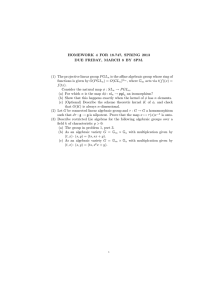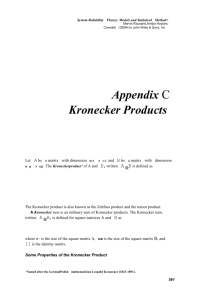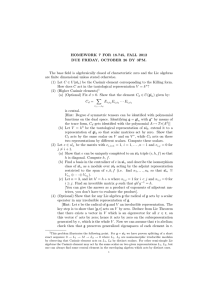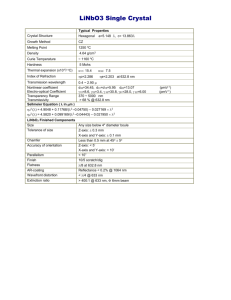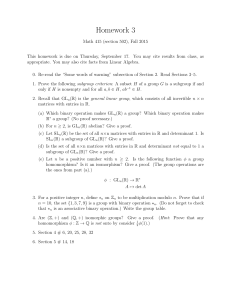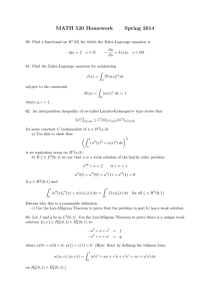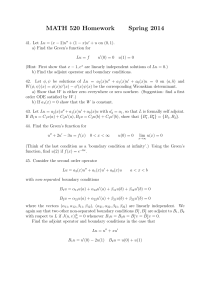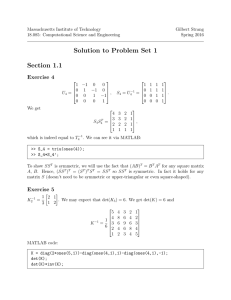On rectangular Kronecker coefficients Laurent Manivel
advertisement
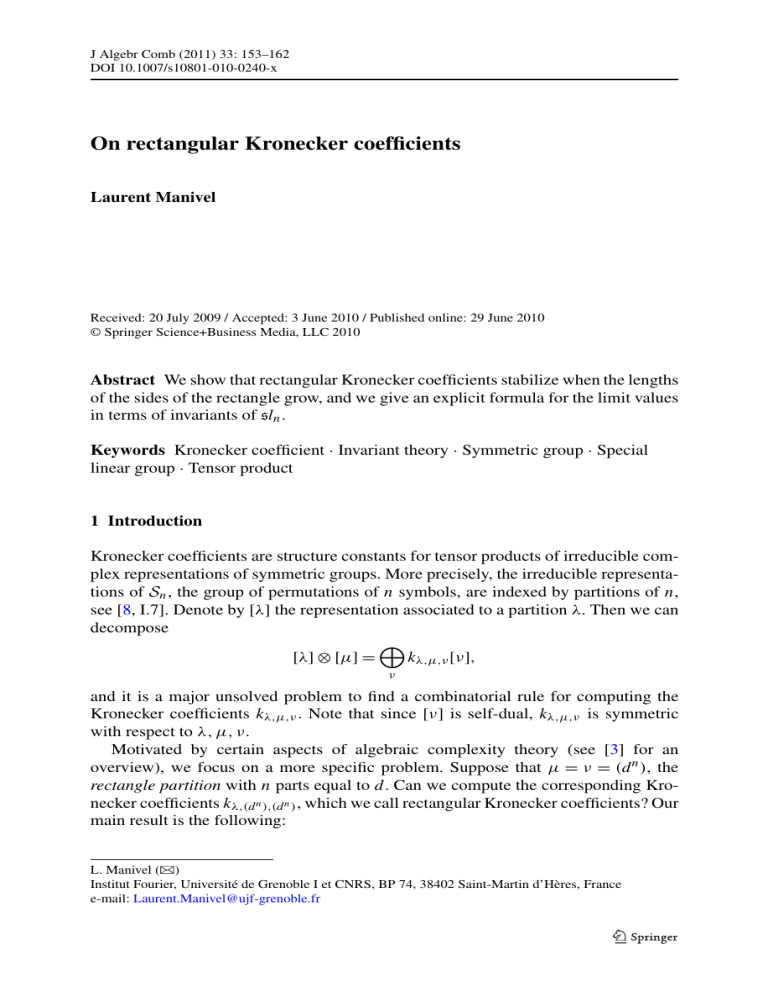
J Algebr Comb (2011) 33: 153–162 DOI 10.1007/s10801-010-0240-x On rectangular Kronecker coefficients Laurent Manivel Received: 20 July 2009 / Accepted: 3 June 2010 / Published online: 29 June 2010 © Springer Science+Business Media, LLC 2010 Abstract We show that rectangular Kronecker coefficients stabilize when the lengths of the sides of the rectangle grow, and we give an explicit formula for the limit values in terms of invariants of sln . Keywords Kronecker coefficient · Invariant theory · Symmetric group · Special linear group · Tensor product 1 Introduction Kronecker coefficients are structure constants for tensor products of irreducible complex representations of symmetric groups. More precisely, the irreducible representations of Sn , the group of permutations of n symbols, are indexed by partitions of n, see [8, I.7]. Denote by [λ] the representation associated to a partition λ. Then we can decompose kλ,μ,ν [ν], [λ] ⊗ [μ] = ν and it is a major unsolved problem to find a combinatorial rule for computing the Kronecker coefficients kλ,μ,ν . Note that since [ν] is self-dual, kλ,μ,ν is symmetric with respect to λ, μ, ν. Motivated by certain aspects of algebraic complexity theory (see [3] for an overview), we focus on a more specific problem. Suppose that μ = ν = (d n ), the rectangle partition with n parts equal to d. Can we compute the corresponding Kronecker coefficients kλ,(d n ),(d n ) , which we call rectangular Kronecker coefficients? Our main result is the following: L. Manivel () Institut Fourier, Université de Grenoble I et CNRS, BP 74, 38402 Saint-Martin d’Hères, France e-mail: Laurent.Manivel@ujf-grenoble.fr 154 J Algebr Comb (2011) 33: 153–162 Theorem 1 Let λ = (dn − |ρ|, ρ) for some partition ρ. Consider the Kronecker coefficient kρ (d, n) = kλ,(d n ),(d n ) . (1) kρ (d, n) is a symmetric, non decreasing function of n and d; (2) for d ≥ |ρ|, the Kronecker coefficient kρ (d, n) is equal to kρ (n) := dim Sρ (sln )GLn . A few words of explanation are in order: the general complex linear group GLn acts by conjugation on the Lie algebra sln of traceless matrices. For any partition ρ there is an induced action of GLn on the Schur power Sρ (sln ), and Sρ (sln )GLn denotes the subspace of invariants of this action. (Note that we could replace GLn by SLn .) Also, we have denoted by |ρ| the sum of the parts of the partition ρ. In the sequel we will denote by (ρ) its length, defined as the number of non-zero parts. 2 Proof of the theorem We first use Schur–Weyl duality to translate the computations of Kronecker coefficients to the setting of GLm -modules and their Schur powers, or equivalently, to a problem involving symmetric functions. By Schur–Weyl duality, we mean the following statement (see, e.g., [6, Theorem 2.4.3]). For a complex vector space V , the Sn × GL(V )-module V ⊗n decomposes as [λ] ⊗ Sλ V . V ⊗n = |λ|=n, (λ)≤dim V An immediate consequence of this statement, which can serve as a definition of Schur functors, is that Sλ V = HomSn [λ], V ⊗n , where by HomSn we mean the space of Sn -equivariant homomorphisms. The statement of Schur–Weyl duality can then be translated into the fact that this defines an irreducible GL(V )-module, with highest weight λ. Another straightforward consequence is that for two vector spaces U, V and three partitions λ, μ, ν of the same integer n, the multiplicity of Sμ U ⊗ Sν V inside Sλ (U ⊗ V ) is equal to the Kronecker coefficient kλ,μ,ν (at least for (μ) ≤ dim U , (ν) ≤ dim V and (λ) ≤ dim U dim V ). Remark 1 If u, v are the dimensions of U , then Sμ+(a u ) U = Sμ U ⊗ (det U )a . Since det(U ⊗ V ) = det(U )v ⊗ det(V )u , the identity Sλ+(a uv ) (U ⊗ V ) = Sλ (U ⊗ V ) ⊗ det(U ⊗ V )a implies that kλ+(a uv ),μ+((av)u ),ν+((au)v ) = kλ,μ,ν for any λ, μ, ν such that (μ) ≤ u, (ν) ≤ v, (λ) ≤ uv. This is the main result of [11]. J Algebr Comb (2011) 33: 153–162 155 Suppose now that V = W ⊕ L for some vector spaces W, L, with dim L = 1. We compute Sλ (U ⊗ V ) in two different ways. First, we can use the previous remark and write Sλ (U ⊗V ) = kλ,μ,ν Sμ U ⊗Sν (W ⊕L) = kλ,μ,ν Sμ U ⊗Sθ W ⊗L|ν|−|θ| . (1) μ,ν μ,ν,θ ν→θ Here we have used a version of the Pieri formula, Sν (W ⊕ L) = Sθ W ⊗ L|ν|−|θ| , ν→θ where the notation ν → θ means that νi ≥ θi ≥ νi+1 for all i. This formula is a special case of a more general formula which is also a consequence of Schur–Weyl duality: applying a Schur functor to a direct sum, one gets α,β Sλ (E ⊕ F ) = cλ Sα E ⊗ Sβ F, |α|+|β|=|λ| α,β where the Littlewood–Richardson coefficient cλ can be defined as the multiplicity of Sλ G inside the tensor product Sα G ⊗ Sβ G, for G of large enough dimension. We can apply this formula to derive α,β Sλ (U ⊗ V ) = Sλ (U ⊗ W ⊕ U ⊗ L) = cλ Sα (U ⊗ W ) ⊗ Sβ U ⊗ L|β| |α|+|β|=|λ| and then, decomposing Sα (U ⊗ W ) with the help of Kronecker coefficients, α,β Sλ (U ⊗ V ) = cλ kα,ρ,θ Sρ U ⊗ Sβ U ⊗ Sθ W ⊗ L|β| . (2) α,β,ρ,θ |α|+|β|=|λ| Comparing with (1), we get the identity α,β ρ,β kλ,μ,ν = cλ kα,ρ,θ cμ . ν→θ α,β,ρ Now we specialize to the case where λ = μ = (d n ). We get α,β ρ,β k(d n ),(d n ),ν = c(d n ) kα,ρ,θ c(d n ) . ν→θ (3) α,β,ρ The Littlewood–Richardson coefficients in this formula are easy to understand: we have the following folklore lemma, which is an easy application of the Littlewood– Richardson rule (and also a version of Poincaré duality for Grassmannians). α,β Lemma 1 If the Littlewood–Richardson c(d n ) is non-zero, then α and β are complementary partitions in the rectangle d × n; that is, αi + βn−i+1 = d ∀i. 156 J Algebr Comb (2011) 33: 153–162 (In particular α1 , β1 ≤ d and αn+1 = βn+1 = 0.) When this condition is satisfied, α,β c(d n ) = 1. Proof Let β c be the complementary partition to β in the rectangle d × n. The α,β Littlewood–Richardson rule asserts that c(d n ) is the number of semi-standard skewtableaux T of shape β c and weight α, whose associated word w(T ) is a lattice permutation (see [8] for details). But the latter condition completely determines T : for any i, the i-th line of T must be filled with i’s. And then its content is β c . This implies that in formula (3), the non-zero contributions to the right-hand side come from the partitions α, β, ρ contained in the rectangle d × n such that α = ρ is complementary to β. We can thus write: k(d n ),(d n ),ν = kα,α,θ . (4) ν→θ α⊂d×n Observe that these two sums are of a quite different nature: the first one is taken over partitions ν of size dn; but the second one is taken over partitions α of the same size as θ ; and this size can be arbitrary. In particular, if we suppose that |α| = |θ | ≤ min(d, n), then the condition that α ⊂ d × n is superfluous. If we simply ask that |θ | ≤ d, the condition α ⊂ d × n amounts to the condition that the length of α does not exceed n, and we can rewrite the previous identity as k(d n ),(d n ),ν = kα,α,θ . ν→θ (α)≤n In particular the right-hand side does not depend on d if d ≥ |θ |. Now, write ν = (dn − |ρ|, ρ) for some partition ρ, and observe that the condition that ν → θ means that dn − |ρ| ≥ θ1 ≥ ρ1 ≥ θ2 ≥ ρ2 · · · . Otherwise said, we ask that dn − |ρ| ≥ θ1 and θ → ρ. In particular, the latter condition implies that, |ρ| ≤ |θ |, and therefore the condition that dn − |ρ| ≥ θ1 follows automatically as soon as d ≥ 2. We can thus rewrite our identity as k(d n ),(d n ),(dn−|ρ|,ρ) = kα,α,θ . (5) θ→ρ (α)≤n In order to interpret the right-hand side, we apply the formula for Schur powers of tensor products to two vector spaces in duality. That is, we write kα,β,θ Sα V ⊗ Sβ V ∨ . Sθ V ⊗ V ∨ = (α),(β)≤dim V By Schur’s lemma, the space of GL(V )-invariants inside Sα V ⊗ Sβ V ∨ = Hom(Sβ V , Sα V ) is non-zero if and only if α = β, in which case it is one-dimensional. Letting V = Cn , we deduce that kα,α,θ . dim Sθ (Endn )GLn = (α)≤n J Algebr Comb (2011) 33: 153–162 157 Here, Endn = sln ⊕ C, hence by the Pieri formula Sθ (Endn ) = θ→ρ Sρ (sln ). We can thus rewrite the identity (5) between Kronecker coefficients as k(d n ),(d n ),(dn−|ρ|,ρ) = dim Sρ (sln )GLn , θ→ρ θ→ρ for any θ such that |θ | ≤ d. But this implies that for any ρ such that |ρ| ≤ d, k(d n ),(d n ),(dn−|ρ|,ρ) = dim Sρ (sln )GLn . Indeed, θ → ρ implies θ = ρ or |ρ| < |θ |, so by induction we are immediately done. This proves the second assertion of the Theorem. The proof of the first assertion is straightforward. First, the sign representation [1m ] of Sm has the property that its tensor product with an irreducible representation [λ] is the irreducible representation [λ∨ ], where λ∨ denotes the transpose partition to λ. Since [1m ] ⊗ [1m ] is just the trivial representation, this implies that [λ] ⊗ [λ] = [λ∨ ] ⊗ [λ∨ ]. Applying this remark to a rectangular partition λ = (d n ), we get λ∨ = (nd ), hence kρ (d, n) = kρ (n, d) ∀ρ. Second, this is a non decreasing function of d because of the semi-group property of Kronecker coefficients: if kλ,μ,ν and kλ ,μ ,ν are non-zero, then kλ+λ ,μ+μ ,ν+ν is also non-zero, and more precisely, kλ+λ ,μ+μ ,ν+ν ≥ max(kλ,μ,ν , kλ ,μ ,ν ). Indeed, let E, F, G be three vector spaces and U be the unipotent subgroup of GL(E) × GL(F ) × GL(G) consisting of triples of strictly triangular matrices, with respect to some choice of basis. Let T be the maximal torus consisting of triples of diagonal matrices in the same basis. Then it is another consequence of Schur–Weyl duality that the invariant algebra A = Sym(E ⊗ F ⊗ G)U , which is a T -module, has weight spaces Aλ,μ,ν of dimension kλ,μ,ν . Then the semi-group property follows from the obvious fact that A is an algebra without zero-divisors. Since k1n ,1n ,n is equal to one, we are done. Remark 2 In the second assertion of the Theorem, we can improve the bound on d as follows: kρ (d, n) = dim Sρ (sln )GLn as soon as 2d ≥ |ρ| + ρ1 . Indeed, for a Kronecker coefficient kα,β,θ to be non-zero, we need that m − θ1 ≤ (m − α1 ) + (m − β1 ), where m = |α| = |β| = |θ | [7, Theorem 2.9.22]. Therefore kα,α,θ = 0 implies that 2λ1 ≤ |θ | + θ1 , so that in (4) we can replace the condition that α ⊂ d × n by (α) ≤ n as soon as 2d ≥ |θ | + θ1 . Remark 3 The case where n = 2 has been considered in [9], where we proved by completely different methods that kρ (d, 2) does not depend on d. More precisely, this Kronecker coefficient is equal to one if and only if ρ is even of length at most 158 J Algebr Comb (2011) 33: 153–162 three or odd of length three (by an odd partition we mean a partition all of whose parts are odd), and zero otherwise. This result was also obtained independently in [5]. From the Theorem we deduce the corresponding statement for the dimension of Sρ (sl2 )GL2 . 3 Complements 3.1 Invariants of matrices We have met the identity dim Sθ (Endn )GLn = kα,α,θ . (α)≤n For a given θ , it implies that the dimension of Sθ (Endn )GLn is a non decreasing function of n, which is equal for n ≥ |θ | = m to the multiplicity of [θ ] inside Cm = [α] ⊗ [α]. |α|=m Observe that Cm is nothing other that the conjugating representation of Sm over C[Sm ]. Indeed, the regular representation of Sm over C[Sm ], with its Sm × Sm module structure defined by the left and right actions of Sm , is given by the same formula (but with exterior tensor products), and the conjugating representation is just the regular representation restricted to the diagonal embedding of Sm inside Sm × Sm . (Of course this is not specific to symmetric groups, see e.g. [12, Theorem 3.2.2].) We denote Cm = diag C[Sm ]. A more transparent way to understand the previous identity is to observe that it is closely related to the fundamental theorems for invariants of matrices. Indeed (see, e.g., [10, Chap. 11, §8], or [4]), the first fundamental theorem asserts that the Sm equivariant map GLn fm,n : diag C[Sm ] −→ End⊗m n n ⊗m , defined by mapping a permutation σ to fm,n (σ ) ∈ End⊗m n = End(C ) fm,n (σ )(X1 ⊗ · · · ⊗ Xm ) = Xσ (1) ⊗ · · · ⊗ Xσ (m) , is surjective. Moreover, the second fundamental theorem asserts that the kernel of fm,n is the sum of the submodules [α]⊗[α] of diag C[Sm ], for (α) > n. In particular, fm,n is an isomorphism for n ≥ m. 3.2 Derangements to sln⊗m ? A first observation is that, since Endn = How can we pass from End⊗m n CIn ⊕ sln , and the identity In is certainly GLn -invariant, we have m GLn m ⊗p GLn End⊗m sln . n p p=0 J Algebr Comb (2011) 33: 153–162 159 Since the left-hand side, for n ≥ m, has dimension m!, we easily deduce that m ⊗m GLn p m (m − p)! = Dm , dim sln = (−1) p p=0 the number of derangements, that is, fixed-point free permutations in Sm . This was already observed in [1], but only under the weaker condition that n ≥ 2m. We can be more precise by making the following observation. We have ⊗m GLn GLn sln = End⊗m ∩ sln⊗m , n and the subspace sln⊗m of End⊗m n can be characterized as the intersection of the kernels of the contractions ⊗m−1 ck : End⊗m n → Endn defined, for 1 ≤ k ≤ m, by applying the trace morphism to the kth factor of End⊗m n . Consider an element fn,m (σ ) for some σ ∈ Sm . Once we have chosen a basis e1 , . . . , en of Cn , we can write it explicitly as fn,m (σ ) = n ∨ ei1 ⊗ eiσ (1) ⊗ · · · ⊗ ei∨m ⊗ eiσ (m) . i1 ,...,im =1 An easy computation then shows that a linear combination a = belongs to the kernel of cm , the last contraction, if and only if na(τ,m) + m−1 σ aσ σ ∈ C[Sm ] ask,m (τ,m) = 0 k=1 for all τ ∈ Sm−1 . Here we have denoted by (τ, m) ∈ Sm the permutation deduced from τ by adding the fixed point m, and by sk,m the transposition exchanging k and m. In this identity, note that (τ, m) has one more fixed point than τ , while sk,m (τ, m) has either the same number of fixed points as τ , or one less. This implies, inductively, that if a = σ aσ σ is annihilated by the contractions c1 , . . . , cm , then all the coefficients of a can be expressed in terms of the coefficients aσ , for σ describing the set of fixed-point free permutations—or derangements. Since we know that the dimension of the space of such a’s is precisely the set of derangements, the coefficients of the derangements must be independent. Let diag C[Sm ]fpf ⊂ diag C[Sm ] be the submodule defined by the derangements in Sm . We deduce from the preceding discussion: Proposition 1 For n ≥ m, there is an isomorphism of Sm -modules GL diag C[Sm ]fpf sln⊗m n . This has the following consequence for rectangular Kronecker coefficients. 160 J Algebr Comb (2011) 33: 153–162 Corollary 1 The limit value kρ of kρ (d, n) for d, n ≥ |ρ|, is equal to the multiplicity of [ρ] inside diag C[Sm ]fpf , the fixed-point free part of the conjugating representation. Although Dm grows very fast with m, the coefficients kρ seem to remain much smaller. For m ≤ 6 their values are given by the following table: k2 = 1, k3 = 1, k4 = 2, k5 = 2, k213 = 1, m = 6, k6 = 4, k321 = 4, k16 = 0, m=2 m=3 m=4 m=5 k11 = 0, k21 = 0, k31 = 0, k41 = 1, k15 = 1, k51 = 1, k23 = 5, k111 = 1, k22 = 2, k211 = 1, k32 = 2, k311 = 3, k42 = 6, k313 = 4, k14 = 0, k221 = 1, k33 = 1, k411 = 4, k2211 = 2, k214 = 2, D2 = 1, D3 = 2, D4 = 9, D5 = 44, D6 = 265. 3.3 Symmetric and skew-symmetric invariants Certain submodules of the tensor algebra of sln have a classical interpretation. Indeed, it is well known that GLn -invariants in the symmetric algebra Sym(sln ) generate a polynomial algebra with generators in degree 2, 3, . . . , n. On the other hand, GLn -invariants in the exterior algebra Λ(sln ) can be interpreted as invariant differential forms on the Lie group SLn , and it follows from classical results by Hopf and Samelson that Λ(sln )GLn is an exterior algebra with generators of odd degrees 3, 5, . . . , 2n − 1. Rephrasing these facts, and taking Remark 2 into account, we get: Corollary 2 (1) For d ≥ m, the Kronecker coefficient k(m) (d, n) is equal to the number of partitions of m into integers between 2 and n. m (2) For d ≥ m+1 2 , the Kronecker coefficient k(1 ) (d, n) is equal to the number of partitions of m into distinct odd integers between 3 and 2n − 1. Note that partitions of m into distinct odd integers are in correspondence with partitions λ of m equal to their own transpose. This is equivalent to the condition that [λ] ⊗ [λ] contains the sign representation, so that the number of partitions of m into distinct odd integers can be expressed as 0 (m) = kλ,λ,(1m ) . podd |λ|=m 3.4 A birational map It may be possible to give a more transparent and more geometric proof of our results starting from the following observation. Let E, F, G be three vector spaces of dimensions n, n, g, with g ≤ n2 . Let γ1 , . . . , γg be a basis of G, and denote by UG the unipotent subgroup of GL(G) consisting of endomorphisms whose matrix in this basis is strictly upper-triangular. Consider a generic element T ∈ E ∨ ⊗ F ⊗ G∨ = Hom(G, Hom(E, F )). The image T (γ1 ) of γ1 is an invertible morphism, which identifies E with F . Under this identification, T (γ1 ) becomes the identity map, and T can J Algebr Comb (2011) 33: 153–162 161 be interpreted as a tensor T̄ ∈ Hom(G/γ1 , End(E)/IdE ), where End(E)/IdE can be identified with sl(E). Since T is generic and g ≤ n2 , T̄ is injective, and we deduce a flag W1 ⊂ · · · ⊂ Wg−1 ⊂ sl(E), where Wk has dimension k. Denoting by Fg−1 (sl(E)) the variety parameterizing such flags, this construction defines a rational map π : P E ∨ ⊗ F ⊗ G∨ //SL(E) × SL(F ) × UG −→ Fg−1 sl(E) //SL(E) which is easily seen to be birational. The left-hand side is Proj(A), where SL(E)×SL(F )×UG U S δ E ∨ ⊗ F ⊗ G∨ = k(d n ),(d n ),λ Sλ G∨ G A= δ≥0 d≥0 is endowed with a natural action of the torus TG of diagonal matrices in GL(G), such that the one-dimensional vector space (Sλ G∨ )UG is acted on by the character defined by λ. In consequence, A is graded over the character group of TG , and the dimension of Aλ is the rectangular Kronecker coefficient k(d n ),(d n ),λ . On the right-hand side, consider a line bundle Lα , whose fiber over a point of Fg−1 (sl(E)) defined by a flag W1 ⊂ · · · ⊂ Wg−1 ⊂ sl(E) is W1α1 ⊗ (W2 /W1 )α2 ⊗ · · · ⊗ (Wg−1 /Wg−2 )αg−1 . If α is a partition, then by the Borel–Weil theorem H 0 Fg−1 sl(E) , L−1 Sα sl(E). α Moreover, any SL(E)-invariant section of L−1 α defines, through π , a rational function on P(E ∨ ⊗ F ⊗ G∨ )//SL(E) × SL(F ) × UG . Multiplying this function by a d-th power of γ1n ∈ S n G Λn E ⊗ Λn F ∨ ⊗ S n G ⊂ S n (E ⊗ F ∨ ⊗ G), this rational function will become regular for d large enough (this is because in the construction of π we have inverted T (γ1 ), and we are now multiplying by some power of its determinant). The weight of the resulting section with respect to TG is easily computed to be (nd − |α|, α), and we finally get a map Sα sl(E)SL(E) −→ A(nd−|α|,α) . Assertion (2) of Theorem 1 can thus be translated into the claim that, for d large enough, this map is an isomorphism. 3.5 A question We have seen that the semi-group property of Kronecker coefficients, and the obvious fact that k(1n ),(1n ),(n) = 1, is enough to ensure that the Kronecker coefficient we denoted kρ (d, n) is a non-decreasing function of n and d. More generally, for any integer δ and any partition λ such that k(δ n ),(δ n ),λ = 0, we can conclude that for any integer d and any partition μ the Kronecker coefficient k(d+mδ)n ,(d+mδ)n ,μ+mλ is a non-decreasing function of m. How does it grow with m? Can one give an explicit equivalent when m → +∞? When is there a finite limit? Of course this problem can also be considered for general Kronecker coefficients. The limit value of km+α,m+β,m+γ , for m → +∞, has been computed in [2, 3.4]. 162 J Algebr Comb (2011) 33: 153–162 References 1. Benkart, G., Doty, S.: Derangements and tensor powers of adjoint modules for sln . J. Algebr. Comb. 16(1), 31–42 (2002) 2. Brion, M.: Stable properties of plethysm: on two conjectures of Foulkes. Manuscr. Math. 80(4), 347– 371 (1993) 3. Buergisser, P., Landsberg, J.M., Manivel, L., Weyman, J.: An overview of mathematical issues arising in the geometric complexity theory approach to VP vs VNP. arXiv:0907.2850 4. Formanek, E.: The invariants of n × n matrices. In: Invariant Theory. Lecture Notes in Math., vol. 1278, pp. 18–43. Springer, Berlin (1987) 5. Garsia, A., Wallach, N., Xin, G., Zabrocki, M.: Kronecker coefficients via symmetric functions and constant term identities. Preprint (2008) 6. Howe, R.: Perspectives on invariant theory: Schur duality, multiplicity-free actions and beyond. In: The Schur Lectures (1992) (Tel Aviv). Israel Math. Conf. Proc., vol. 8, pp. 1–182. Bar-Ilan Univ., Ramat Gan (1995) 7. James, G., Kerber, A.: The Representation Theory of the Symmetric Group. Encyclopedia of Mathematics and its Applications, vol. 16. Addison-Wesley, Reading (1981) 8. Macdonald, I.G.: Symmetric Functions and Hall Polynomials, 2nd edn. Oxford University Press, Oxford (1995) 9. Manivel, L.: A note on certain Kronecker coefficients. Proc. Am. Math. Soc. 138, 1–7 (2010). arXiv: 0809.3710 10. Procesi, C.: Lie Groups, An Approach Through Invariants and Representations. Universitext. Springer, Berlin (2007) 11. Vallejo, E.: A stability property for coefficients in Kronecker products of complex Sn characters. Electron. J. Comb. 16(1) (2009), Note 22, 8 pp. 12. Weintraub, S.: Representation Theory of Finite Groups: Algebra and Arithmetic. Graduate Studies in Mathematics, vol. 59. AMS, Providence (2003)
